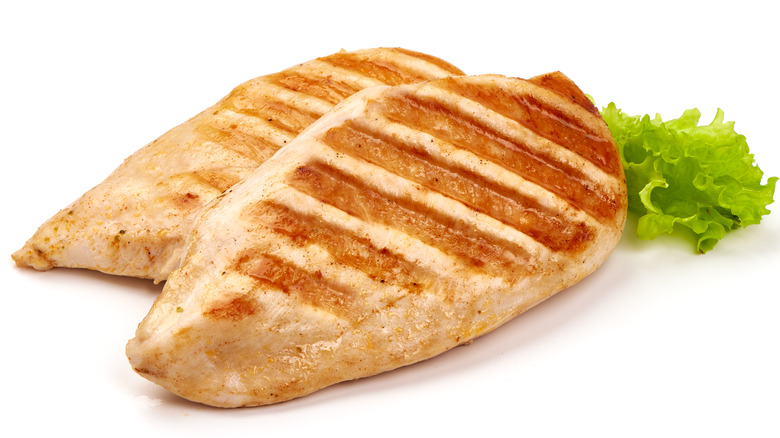How The USDA Is Trying To Reduce Chicken Salmonella Contamination
The U.S. Department of Agriculture has unveiled a sweeping new set of standards for the American poultry industry, in hopes of reducing the ever-looming threat of a widespread salmonella outbreak. According to an Associated Press report, the USDA is taking new steps towards tackling the root of the salmonella problem in poultry plants and farms.
Salmonella, a foodborne illness that can result in stomach pain, fever, diarrhea, and in severe cases, hospitalization and death, has long been linked to the poultry industry. Of the 1.35 million salmonella infections that occur in the U.S. every year — which result in over 25,000 hospitalizations and 420 deaths annually — a whopping 23% of those infections are linked to poultry. The USDA hopes that by encouraging more hygienic farms and processing facilities, they'll be able to decrease the number of severe illnesses that occur each year and ease Americans' concerns about handling raw chicken and turkey.
"Some consumers have told us they feel like they have to handle chicken like it's toxic waste," Brian Ronholm, a former USDA secretary currently overseeing food policy for Consumer Reports, told the AP. "We're hopeful that these steps laid out by the USDA will result in more consumer confidence about the poultry products they bring into their homes."
The new strategies proposed by the USDA involve safety measures taken at both the farms where chickens are bred and at meat processing plants.
The plan to fight harmful bacteria
The USDA has placed a new emphasis on encouraging poultry farmers to utilize probiotic-rich food and vaccinations among their flock, in addition to calling for increased cleanliness of the animals' shelter and food and water supplies. Although poultry processing plants are already tested for traces of salmonella, the agency hopes to increase testing and introduce new tests that scan specifically for the strains of salmonella that most commonly result in infections.
A spokesman for The National Chicken Council told the AP that the poultry industry as a whole continues to enthusiastically work to prevent and contain salmonella outbreaks, taking steps such as spraying raw chicken at processing plants with germ-killing solutions. While America's poultry plants have made strides towards meeting the USDA's standards for limited salmonella — currently 89% of the country's plants are meeting the standard, up from 71% three years ago — health and safety regulators recognize that the country still has a ways to go.
That said, spokespeople for the National Chicken Council admit that there is no law or regulation that could ever make raw chicken a "100% sterile product."
Advocates say there is more the USDA could do
According to Joel Brandenberger, President of the National Turkey Federation, the collaborative effort the USDA has proposed is the most effective way to limit the risk of salmonella. "Because there is no simple solution, improving food safety requires the type of collaborative approach USDA is advocating," Brandenberger told the AP. On a household level, the USDA continues to urge home cooks to cook poultry thoroughly to kill germs found on the meat, and to not wash raw chicken, which can result in bacteria spraying onto other kitchen surfaces.
Despite the recent push towards eliminating salmonella risk factors, some, like the food safety regulation advocacy group Food and Water Watch, told the AP that the USDA isn't doing enough to protect Americans. Food and Water Watch has advocated for the government to outlaw the sale of meat detected to have salmonella bacteria on it, which is currently legal in the United States.
While the USDA has yet to take the step of criminalizing the sale of salmonella-containing meat products, the governmental organization hopes that the new recommendations will continue to move the American poultry industry in the right direction.


